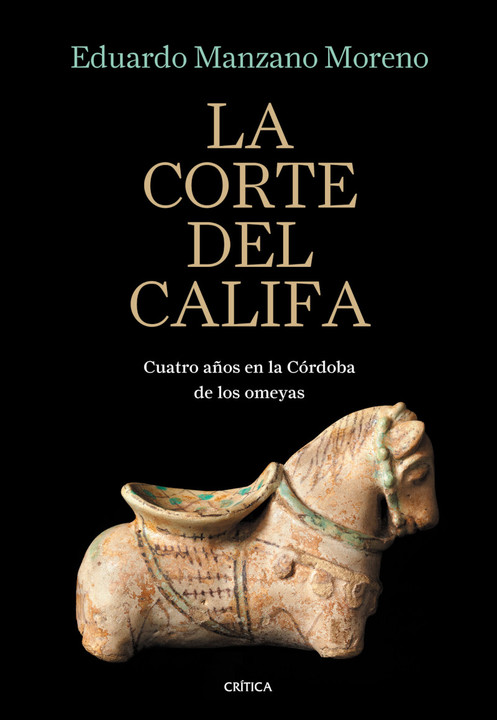Books and publications
Index / Activities / Books and publications / “The Caliph’s Court: Four years in the Cordoba of the Umayyad caliphs”
“The Caliph’s Court: Four years in the Cordoba of the Umayyad caliphs”
May 08, 20197:00 p.m.
MADRID
Casa Árabe Auditorium (at Calle Alcalá, 62).
7:00 p.m.
Free entry until the event’s capacity is reached.
In Spanish.
On Wednesday, May 8, historian Eduardo Manzano is presenting his latest
work, published by the Crítica publishing firm, at the Casa Árabe
headquarters in Madrid.
Taking part in the event with the author is Antonio Vallejo Triano, former director of the archeological site of Medina Azahara. Presented by: Pedro Martínez-Avial, the General Director of Casa Árabe.
During the second half of the tenth century, the Cordoba caliphate became the greatest political and cultural power in the Western world. A place visited by embassies and merchants arriving from every corner of the Mediterranean, Al-Andalus lived an era of splendor. The height of this supremacy occurred in the times of caliph al-Hakam II (961-976), famous for having one of the largest libraries in that historical period, for his works to expand the Cordoba Mosque and for the sumptuous character of the palatine city in which he lived, Madīnat al-Zahrāʼ, located a few kilometers outside of the capital.
This book La corte del califa. Cuatro años en la Córdoba de los califas omeyas (The Caliph’s Court: Four years in the Cordoba of the Umayyad caliphs) is based on an extraordinary text that has never been subjected to a thorough study: the annals which a civil servant and chronicler from the caliph’s court took down on almost a daily basis from June of 971 to July of 975, allowing him to provide an enormous fresco showing the Umayyad caliphate through the words of a living witness. Through it we are able to view the steps taken by the caliph and his entourage through today’s map of Cordoba and the ruins which can still be seen in Madīnat al-Zahrāʼ, while learning how the caliph’s administration was run and the major problems of the army in the wars it undertook in northern Morocco and at the border with the Christians in the Douro River valley.
Eduardo Manzano Moreno is a researching professor at the CSIC’s Center for Human and Social Sciences. His work has focused on the history of Al-Andalus and on the social implications of History as a field of study and the profession of historians. He has led numerous research projects which revolve around these two topics, about which he has also had a large number of articles and book chapters published both inside and outside of our country. Also notable amongst his works are Conquistadores, emires y califas. Los Omeyas y la formación de al-Andalus, (Conquerors, Emirs and Caliphs: The Umayyads and the formation of Al-Andalus, Crítica, 2007); “The Iberian Peninsula and North Africa,” in The New Cambridge History of Islam, Ch. Robinson, vol. II , 2009 and La gestión de la memoria. La historia de España al servicio del poder (Managing Memory: The history of Spain in the service of power), authored with Sisinio Pérez Garzón, Aurora Riviére and Ramón López Facal (Crítica, 2000).
During the second half of the tenth century, the Cordoba caliphate became the greatest political and cultural power in the Western world. A place visited by embassies and merchants arriving from every corner of the Mediterranean, Al-Andalus lived an era of splendor. The height of this supremacy occurred in the times of caliph al-Hakam II (961-976), famous for having one of the largest libraries in that historical period, for his works to expand the Cordoba Mosque and for the sumptuous character of the palatine city in which he lived, Madīnat al-Zahrāʼ, located a few kilometers outside of the capital.
This book La corte del califa. Cuatro años en la Córdoba de los califas omeyas (The Caliph’s Court: Four years in the Cordoba of the Umayyad caliphs) is based on an extraordinary text that has never been subjected to a thorough study: the annals which a civil servant and chronicler from the caliph’s court took down on almost a daily basis from June of 971 to July of 975, allowing him to provide an enormous fresco showing the Umayyad caliphate through the words of a living witness. Through it we are able to view the steps taken by the caliph and his entourage through today’s map of Cordoba and the ruins which can still be seen in Madīnat al-Zahrāʼ, while learning how the caliph’s administration was run and the major problems of the army in the wars it undertook in northern Morocco and at the border with the Christians in the Douro River valley.
Eduardo Manzano Moreno is a researching professor at the CSIC’s Center for Human and Social Sciences. His work has focused on the history of Al-Andalus and on the social implications of History as a field of study and the profession of historians. He has led numerous research projects which revolve around these two topics, about which he has also had a large number of articles and book chapters published both inside and outside of our country. Also notable amongst his works are Conquistadores, emires y califas. Los Omeyas y la formación de al-Andalus, (Conquerors, Emirs and Caliphs: The Umayyads and the formation of Al-Andalus, Crítica, 2007); “The Iberian Peninsula and North Africa,” in The New Cambridge History of Islam, Ch. Robinson, vol. II , 2009 and La gestión de la memoria. La historia de España al servicio del poder (Managing Memory: The history of Spain in the service of power), authored with Sisinio Pérez Garzón, Aurora Riviére and Ramón López Facal (Crítica, 2000).

